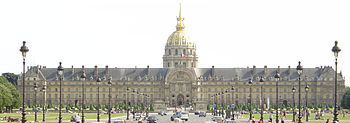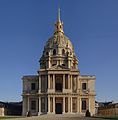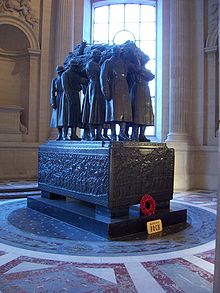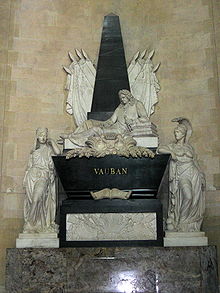- Les Invalides
-
This article is about the area in Paris. For the Paris metro station serving it, see Invalides (Paris Métro and RER).
Coordinates: 48°51′18″N 2°18′45″E / 48.855°N 2.3125°E
L'Hôtel national des Invalides 
View from the Eiffel TowerAlternative names Les Invalides, Musée de l'Armée General information Type Museum, Church, Hospital, Retirement home, Mausoleum Architectural style Baroque Construction started 1670 Inaugurated 1679 Design and construction Architect Libéral Bruant, Jules Hardouin Mansart Les Invalides (French pronunciation: [lezɛ̃valid]), officially known as L'Hôtel national des Invalides (The National Residence of the Invalids), is a complex of buildings in the 7th arrondissement of Paris, France, containing museums and monuments, all relating to the military history of France, as well as a hospital and a retirement home for war veterans, the building's original purpose. The buildings house the Musée de l'Armée, the military museum of the Army of France, the Musée des Plans-Reliefs, and the Musée d'Histoire Contemporaine, as well as the burial site for some of France's war heroes, notably Napoleon Bonaparte (lists below).
Contents
History
Louis XIV initiated the project by an order dated 24 November 1670, as a home and hospital for aged and unwell soldiers: the name is a shortened form of hôpital des invalides. The architect of Les Invalides was Libéral Bruant. The selected site was in the then suburban plain of Grenelle (plaine de Grenelle). By the time the enlarged project was completed in 1676, the river front measured 196 metres and the complex had fifteen courtyards, the largest being the cour d'honneur ("court of honour") for military parades. It was then felt that the veterans required a chapel. Jules Hardouin Mansart assisted the aged Bruant, and the chapel was finished in 1679 to Bruant's designs after the elder architect's death. The chapel is known as Église Saint-Louis des Invalides. Daily attendance was required.
Shortly after the veterans' chapel was completed, Louis XIV commissioned Mansart to construct a separate private royal chapel referred to as the Église du Dôme from its most striking feature (see gallery). Inspired by St. Peter's Basilica in Rome the original for all Baroque domes, it is one of the triumphs of French Baroque architecture. Mansart raised its drum with an attic storey over its main cornice, and employed the paired columns motif in his more complicated rhythmic theme. The general programme is sculptural but tightly integrated, rich but balanced, consistently carried through, capping its vertical thrust firmly with a ribbed and hemispherical dome. The domed chapel is centrally placed to dominate the court of honour. It was finished in 1708.
The interior of the dome (see gallery) was painted by Le Brun's disciple Charles de La Fosse with a Baroque illusion of space (sotto in su) seen from below. The painting was completed in 1705.
Architecture
On the north front of Les Invalides (illustration, right) Hardouin-Mansart's chapel dome is large enough to dominate the long façade, yet harmonizes with Bruant's door under an arched pediment. To the north, the courtyard (cour d'honneur) is extended by a wide public esplanade (Esplanade des Invalides) where the embassies of Austria and Finland are neighbours of the French Ministry of Foreign Affairs, all forming one of the grand open spaces in the heart of Paris. At its far end, the Pont Alexandre III links this grand urbanistic axis with the Petit Palais and the Grand Palais. The Pont des Invalides is next, downstream the Seine river. The Hôpital des Invalides spurred William III of England to emulation, in the military Greenwich Hospital of 1694.
The buildings still comprise the Institution Nationale des Invalides [2], a national institution for disabled war veterans. The institution comprises:
- a retirement home
- a medical and surgical centre
- a centre for external medical consultations.
Gallery
-
According to an old tradition, battle trophies decorate the vault of the chapel of Saint-Louis-des-Invalides.
-
Emperor Qianlong's military costume at the Musée de l'Armée.
Tombs and vaults
Tombs
Marshal Vauban's tomb
The most notable tomb at Les Invalides is that of Napoleon Bonaparte (1769–1821). Napoleon was initially interred on Saint Helena, but King Louis-Philippe arranged for his remains to be brought to France in 1840, an event known as le retour des cendres. Napoléon's ashes were first buried in the Chapelle Saint-Jérôme in the Invalides until his final resting place, a tomb made of red quartzite and resting on a green granite base, was finished in 1861.Some members of Napoleon's family, several military officers who served under him, and other French military heroes are also buried at Les Invalides:
- Henri Gratien, Comte Bertrand (1773–1844), army general during the First French Empire who accompanied Napoleon to Elba and then St Helena. He brought Napoleon's body back to France in 1840.
- Joseph Bonaparte (1768–1844), Napoleon's elder brother.
- Jérôme Bonaparte (1784–1860), Napoleon's youngest brother.
- Napoleon II (1811–1832) son of Napoleon.
- Thomas Bugeaud (1784–1849), Marshal of France and conqueror of Algeria.
- François Canrobert (1809–1895), Marshal of France.
- Geraud Duroc (1774–1813), general who fought with Napoleon.
- Claude Joseph Rouget de Lisle (1760–1836), army captain, author of France's national anthem, La Marseillaise.
- Ferdinand Foch (1851–1929), Marshal of France, Allied Supreme Commander in the First World War.
- Henri de la Tour d'Auvergne, Vicomte de Turenne (1611–1675), better known as Turenne, Marshal General of France under Louis XIV and one of France's greatest military leaders.
- Sébastien Le Prestre de Vauban's heart (1633–1707), designer of Louis XIV's military fortifications.
- Pierre Auguste Roques (1856–1920), founder of the French Air Force and Minister of War in 1916.
- Philippe Leclerc de Hauteclocque (1902–1947), Marshal of France, hero of World War II, commander of the famous 2nd Armored Division.
- Jean de Lattre de Tassigny (1889–1952), Marshal of France, commander of the French First Army during World War II and later commander in the First Indochina War.
Vaults
The bodies of the following are interred in the vaults of Les Invalides:
- Marshal Lyautey
- General Robert Nivelle
- General Charles Mangin
- Marshal de Mac-Mahon
- Marshal Leclerc de Hauteclocque
- 14 victims of the attack of Fieschi of July 28, 1835
- Marshal General Turenne (1800)
- General Lasalle (1809)
- General Lariboisière (1812)
- Marshal Bessières (1813)
- Marshal Jourdan (1833)
- Marshal Lobau (1839)
- General Bertrand (1844)
- Marshal Valée (1846)
- Admiral Duperré (1847)
- General Duroc (1847)
- Marshal Sérurier (1847)
- General Duvivier 1848
- Marshal Bugeaud (1849)
- Marshal Sébastiani (1851)
- Marshal Exelmans (1852)
- Marshal Saint-Arnaud 1854
- Admiral Hamelin (1864)
- Marshal Pélissier, duke de Malakoff (1864)
- Marshal Regnault of Saint-Jean-d'Angély (1870)
- Marshal Baraguay d'Hilliers 1878
- Marshal Canrobert 1895
- General Paul Edouard Arnoux, Commandant des Invalides (1891–1902)
- General Lasalle (1897)
- Claude Joseph Rouget de Lisle, composer of La Marseillaise (1915)
- General Roques (1920)
- General Louis de Maud'huy 1921
- General Humbert 1921
- General Maistre 1922
- Marshal Maunoury (1923)
- General Malleterre 1923
- General of Mitry 1924
- Admiral Boué de Lapeyrère (1852–1924)
- General Lanrezac (1925)
- General Putz 1925
- General Baucheron de Boissoudy (1926)
- General Gerard (1926)
- General Ruffey 1926
- General of Langle de Cary 1927
- Marshal Fayolle (1928)
- General Sarrail (1929)
- Vice-admiral Gauchet (1931)
- General Pau 1932
- Vice-admiral Fournier 1934
- General Cordonnier 1936
- Admiral Guépratte 1939
- Admiral Ronarc'h 1940
- General Guillaumat 1940
- General d'Amade 1941
- General d'Urbal 1943
- Marshal Franchet d' Esperey (1942)
- General Henrys 1944
- General Henri Giraud 1949
- General Duchêne 1950
- General Hodenmoon 1959
- General Kitzler 1962
- General Monclar (1964)
- Marshal Juin (1967)
The hearts of the following are interred in the vaults of Les Invalides while their bodies rest elsewhere:
- Jean Beryrand, lord of Senneric 1691
- General Jean Baptiste Kléber
- General Jean-Joseph Ange d'Hautpoul 1807
- Major general de Bisson 1811
- Major general Jean Baptiste Eblé (1813)
- Lieutenant general Baraguay d'Hilliers (1813)
- Marie Maurille de Sombreuil, countess of Villelume (1823)
- Lieutenant-general of Conchy (1823)
- Major general Négrier 1848
Works inspired or influenced by Les Invalides
- The present dome of the United States Capitol, designed by Thomas U. Walter, was inspired in part by the dome at Les Invalides. Both are "wedding-cake" style double-shelled domes with an oculus in the inner shell allowing those below to view a circular painting on the inner surface of the outer dome. The Capitol dome's architect Thomas U. Walter, had previously visited Les Invalides, and is said to have been struck by it.
- San Francisco City Hall Built in 1914-1915, opened in the latter year.
- The United States Naval Academy Chapel in Annapolis, Maryland USA, built 1904-1908, architect Ernest Flagg. The chapel was enlarged in 1940, changing it from a Greek cross to a Roman cross. The new section was designed by Philadelphia architect Paul Cret. John Paul Jones is buried in the crypt in a sarcophagus made of marble from the Pyrenees donated by the people of France.
- Panteón de los Héroes built in 1864 and finished in 1936. Cultural Patrimony of Asunción,[1] it's an oratory of the Assumption of Mary and inside it rest some of the greatest heroes of Paraguay like Francisco Solano López, José Félix Estigarribia and others. Designed by the Italian architect Alessandro Ravizza.
See also
- List of museums in Paris
- List of hospitals in France
- List of tallest structures in Paris
- Military history of France
- San Francisco City Hall, the design of which was influenced by Les Invalides
- La Tour-Maubourg, adjacent Paris Metro stop convenient to Les Invalides
References
External links
- Official site
- Aerial views of Les Invalides, from website for Michele Michahelles, architect who restored the site in 1986[dead link]
Popular visitor attractions in Paris Arc de Triomphe • Sacré-Cœur • Cathedral of Notre Dame • Centre Georges Pompidou • Champs-Élysées • Conciergerie • Eiffel Tower • Grand Palais • Jardin du Luxembourg • Les Invalides • Louvre • Musée d'Orsay • Panthéon • Opéra Garnier • Père Lachaise Cemetery • Château de Vincennes • Sainte-Chapelle Categories:
Categories:- Visitor attractions in Paris
- 1670s architecture
- Baroque buildings in France
- Monuments and memorials in Paris
- Cemeteries in Paris
- Military veterans' affairs in France
- Military-related organizations
- Roman Catholic churches in the 7th arrondissement of Paris
Wikimedia Foundation. 2010.













